

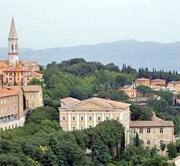
A community of Poor Clares here was first documented in 1279. The church was originally dedicated to Santa Maria degli Angeli, but became known as Santa Maria dei Fossi in ca. 1420, when Braccio Fortebraccio built the adjacent extension to the city walls, along with defensive ditches (“fossi”). The nunnery burned down in 1430 and the nuns moved to Santa Maria di Monteluce. Some of them returned in 1444 as a reformed community that was supervised by a small and separate community of Franciscan friars. An epidemic wiped out most of them in 1464, at which point the nunnery passed to the direct jurisdiction of Santa Maria di Monteluce.
In 1468, the the complex passed to the Augustinian Canons of San Salvatore, Venice, a move that was approved in that year in a bull issued by Pope Paul II (the Venetian, Pietro Barbo). A local chronicle records that the canons practically rebuilt the monastery and built a new church. They received subventions from the Commune on a number of occasions, starting in 1470, and they also acquired a number of important private patrons. In 1495 they commissioned the Lombard master Giovanni di Giovannino da Melide to construct the tribune of the church. The building work probably ended in 1505 with the construction of the cloister.
The canons were required to leave the complex for the period 1643-4, when it was used as a military hospital in the war between Pope Urban VIII and Duke Ferdinando II de' Medici.
The community was suppressed in 1789, and the complex passed to the Ospedale di Santa Maria della Misericordia. However, there were insufficient funds to pursue the planned mental hospital on the site, so Bishop Alessandro Odoardi bought it back in 1797 and adapted it as an orphanage for boys that was known as the Orfanatrofio della Divina Misericordia. When the nunnery of San Sperandio was suppressed in 1799, its goods were transferred to this orphanage.
This orphanage and that from SS Annunziata moved to Santa Maria delle Orfane delle Cappuccinelle in the early 19th century, and the orphanage for girls that existed there moved here.
The complex was converted into a college for the daughters of noble families in 1857 after a radical remodelling that included the current neo-Classical facade. It was then known as the Collegio di Sant’ Anna. The church was deconsecrated in the 1970s and the complex now houses two schools, the Scuola Media Statale San Paolo and the Scuola Media Bernardino di Betto, together with the Istituto di Formazione Culturale Sant’ Anna.
Ex-Church
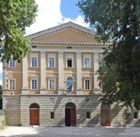
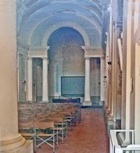
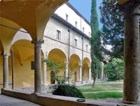
Works of Art Removed from the Church
Santa Maria dei Fossi Altarpiece (1496)
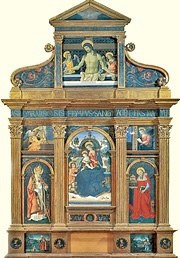
It seems likely that Pintoricchio had been associated with the project for some time, and that he had designed the frame and probably planned the composition. However, a series of codicils to Melchiorre’s will reduced had reduced the sum of money that was available for the commission, and it was only in February 1495 that sufficient funds were in place to support a formal contract. This was agreed between the artist and Prior Girolamo di Francesco da Venezia, who specified the iconography of the altarpiece in some detail. Alfano Alfani administered the funds that were deposited by the canons and paid to Pintoricchio, who was compensated for the rent of a workshop and undertook to complete the work in two years.
This was the most important commission that Pintoricchio ever received in his native Perugia, and it received extraordinary acclaim when it was unveiled. It was influential with other contemporary artists, including the young Raphael. It was still in situ in 1732 but had been dismembered by 1784, when its components were in the choir. The panels escaped the Napoleonic expropriations and were reconstituted in the original frame in 1863. The altarpiece is now in the Galleria Nazionale.
The canons designed the iconography of the altarpiece in order to tell the story of the incarnation of Christ as a prelude to the redemption of mankind:
-
✴Small panels flanking the upper part of the central panel depict the figures of the Annunciation.
-
✴The central panel depicts the Madonna and Child enthroned with the young St John the Baptist, who hands a reed Cross to the baby Jesus as a sign of His fate. Christ holds a pomegranate, the symbol of redemption. The inscription underneath reads: “O holy child [i.e. St John], give this cross to the Child. You will not carry it to God on behalf of the world; there will be another”.
-
✴The panel in the top register depicts the Pietà, with angels holding the arms of the dead Christ, revealing His wounded hands. The inscription below, which may not be original, translates: “Look, O mortal, by what blood you have been redeemed. Make sure that it has not been shed in vain”.
Two of the doctors of the church are shown in meditation in the main side panels:
-
✴The presence of St Jerome was specified in the will of Melchiorre di Goro. He is dressed as a cardinal, is accompanied by his lion, and carries a model of a centrally-planned church with a portico. This church, which is repeated in the landscape to the left of the Madonna’s throne, does not seem to represent Santa Maria degli Angeli but might represent the Pantheon, Rome.
-
✴St Augustine, the founder of the order to which the canons of Santa Maria degli Angeli belonged, carries an apple as a symbol of redemption.
All of this faithfully reflected the terms of the original contract. However, this was not the case with the predella panels:
-
✴The tondi under the four pilasters contain representations of the Evangelists.
-
✴The predella panel below the figure of St Augustine depicts a scene in which he speaks to a child who is trying to pour the sea, cup by cup, into a hole in the sand. The story goes that, when St Augustine asked her how she could hope to succeed in this immense task, she asked him how he could hope to understand the mystery of Christ’s incarnation.
-
✴The central predella panel, which depicted the baptism of Christ, was replaced at some point by a “mediocre copy” that was in turn lost when the polyptych was dismembered in the 18th century.
-
✴The predella panel below the figure of St Jerome depicts him as a hermit in the dessert, contemplating the Crucifixion.
These scenes, although entirely logical and consistent with the specified iconography for the rest of the altarpiece, bear no resemblance to those specified in the contract:
-
✴the panels under the four pilasters were to represent:
-
•St Ubald (the patron saint of Gubbio, who had imposed the canonical rule in the cathedral there in the 12th century);
-
•St Bernard (probably St Bernard of Rodez since he was to be dressed as a regular canon);
-
•St Joseph; and
-
•a saint whose name is difficult to read but was apparently St Dignamerita;
-
✴the central predella panel was to represent Pope Alexander VI “in majesty” with four cardinals and five canons “at their feet”; and
-
✴each of the other two panels was to represent a cardinal “in majesty”, with a bishop, a canon and a kneeling “convert”.
It is obvious that this part of the commission was largely imposed upon the canons by someone close to Alexander VI. At least two (not mutually exclusive) possible candidates arise:
-
✴Pintoricchio, who had been commissioned to paint the frescoes of the Borgia Apartments of the Vatican Palace in 1492-4 and was documented shortly thereafter as “magister Berarinus pictor palatii apostolici” (effectively as court artist); and
-
✴Alfano Alfani, whom Alexander VI was to appoint as vice-treasurer of the Apostolic Province of Umbria in 1499.
Alexander VI and his young son, then Cardinal Cesare Borgia, must have been duly gratified when they heard about the commission during their 16-day stay in Perugia in June 1495. However, they apparently departed among the curses of the citizens, presumably because of their own behaviour and that of their considerable entourage. This could very well account for the fact that the scheme for the predella was subsequently changed.
Holy Family with St Anne (1502)
Angelo di Tommaso Conti commissioned this altarpiece, which is signed by Perugino and dated, for the Cappella di Sant' Anna. It is unusual in the number of members of the holy family, both adult and infant, that are included in the composition.
It was moved to the Ospedale di Santa Maria della Misericordia in 1789. Napoleon's commissioner, Jacques-Pierre Tinet selected it for confiscation in 1797, and it was sent from Paris to Marseilles in 1801. It is now in the Musée des Beaux Arts, Marseilles and illustrated in the Web Gallery of Art.
Read more:
G. Noszlopy and S. May, “Reflections of Patronage, Form, Iconography and Politics in Pintoricchio’s Fossi Altarpiece”, Arte Cristiana 95 (2007) pp 343-60 and 401-10
Return to Monuments of Perugia.
Return to Walk IV.

